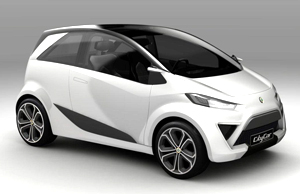
SAN JOSE, CA – A thrifty small vehicle from British sports-car maker Lotus will offset the company’s aspirations at the upper end of the market, a key executive says.
Arnie Johnson, director of operations at Lotus Cars USA, says the Hethel, U.K.-based company’s small car resembles the Cygnet from Aston Martin.
“It would help to have something like that in the mix,” he tells Ward’s during a media preview here of the new-for-’11 Evora S 2-seater.
Luxury car maker Aston Martin, also based in the U.K., begins selling the Cygnet this year in Europe, which is built on Toyota’s iQ micro-car platform.
Aston Martin believes its well-heeled customers want a small luxury car to knock around town as an alternative to the big DB9 and Vantage products they also likely have in their garages.
The Cygnet gives Aston Martin’s fleet greater fuel efficiency, as well, at a time when governments are cracking down on gas-guzzlers and demanding fewer carbon-dioxide emissions.
In the U.S., for example, all of the auto maker’s cars are subject to a gas-guzzler tax, according to the Environmental Protection Agency’s 2011 Fuel Economy Guide.
Lotus could find itself facing similar consequences.

The U.K. auto maker plans to grow its product offerings beyond the current Exige, Elise and Evora line of 2-seaters – cars that achieve up to a relatively economical 27 mpg (8.6 L/100 km) on the highway – to include a $200,000 Eterne sedan with a V-8 engine to challenge the Porsche Panamera 4-door in 2015.
Additional new products, such as the 2-seat Esprit due in 2013 or early 2014 (also costing about $200,000), are expected to feature the V-8 or a V-6 carved out of the same architecture.
Johnson admits Lotus is setting a difficult course by adding a small fuel-sipper, as shown in EV form in Paris last year, given its focus on raising the race-track-oriented brand’s status with bigger, more-luxurious vehicles.
“It’s a tough thing,” he says. “You’re trying to elevate the brand and at the same time you bring in a low-end car. But the obvious reason is to bring your (CAFE) average up.
Lotus and its Malaysian parent, Proton, are developing the small car together, as part of a $53 million investment in Lotus by the national car company.
Lotus will make a 3-door sports car version for global sales, and Proton will build a 5-door compact for the Middle East and Asia that was unveiled at the Malaysia international auto show in December. The cars reportedly are due in the next 18 to 24 months.
The new V-8 going into the future large cars will come from Lotus, Johnson confirms.
The auto maker originally intended to use the 5.0L V-8 found in the Lexus IS-F, a logical extension of a collaboration between the two car companies that currently sees Lotus using a 3.5L Toyota engine for the Evora.
“Looking at what we wanted to get out of the Lexus engine, it would cost more, or at least as much, to do our own engine,” Johnson says. “So we’ll start with (our own) V-8, and then do a V-6 version and a 4-cyl.”
Johnson believes Lotus also could go with a larger displacement than the Toyota 5.0L, but whether the company will build the engine itself remains an open question.
“We did our (last) V-8 in-house, and at the time management farmed (the manufacturing) out,” he says, noting the same could happen again.
A contract-build of the engine also would be likely given the cadre of new executives with extensive industry contacts on board at Hethel, including Chief Technical Officer Wolf Zimmerman, who came over from Mercedes’ AMG performance division. Former General Motors Vice Chairman Bob Lutz serves on the Lotus board of directors.
The new V-8’s first application will be the Esprit, but the switch from the Toyota engine will delay the car’s original timetable of spring 2013.
Johnson reports no direct talks at Lotus of doing a pure EV as shown in Paris. This despite the auto maker also unveiled an Evora 414 E at last year’s Geneva auto show using a pair of electric motors, a lithium-ion battery and range-extending 3-cyl. engine.
Expect hybrid technology from the auto maker, but “not so much for fuel economy as for boosted horsepower,” he says.
As for the new Elise, a car that in the previous decade returned Lotus to the U.S. and put it back on the world map, the latest version will be a more passenger-friendly interpretation of the race-ready sports car when it arrives here in 2015.
“It’ll be light,” Johnson promises. “We’ll target about 2,400 lbs. (1,179 kg), but bigger than the current one (and) a lot more horsepower. The power to weight ratio will be the same. But it also will include creature comforts.
“We have a problem with the Elise,” he confesses. “Everyone loves it, but it is a very hard car to live with.”
Back in the early 2000s, when the global economy was roaring, the Elise was an affordable third, fourth or even fifth car for an enthusiast. But today’s post-recession world calls for the sports car to pull double-duty as a daily commuter.
“The raw little thing with nothing in it has had its day,” Johnson says of the former car.




